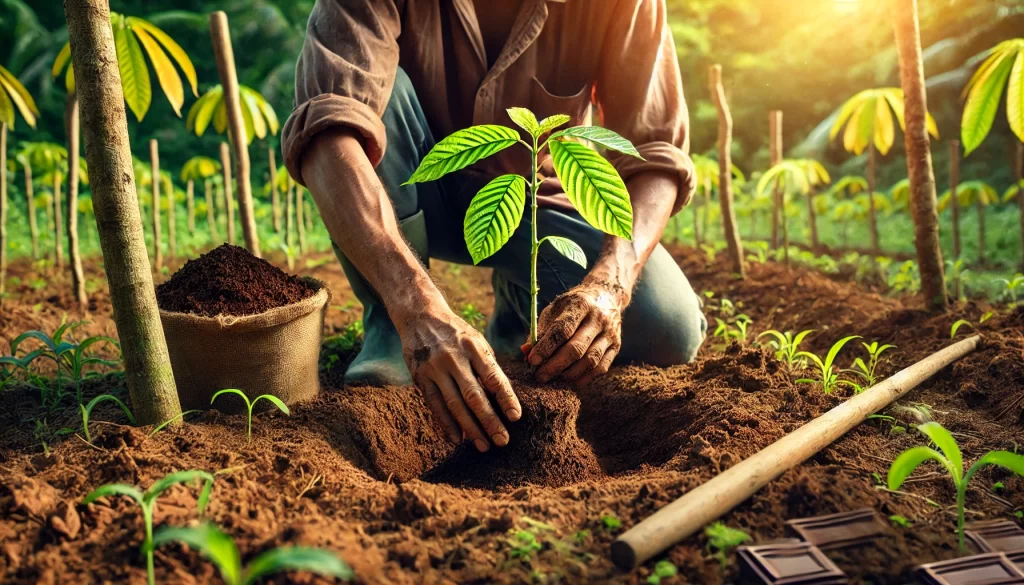- This topic is empty.
- AuthorPosts
- January 21, 2025 at 11:19 pm #543487

Cocoa farming is an essential agricultural practice that contributes significantly to the global chocolate industry and supports millions of farmers, particularly in tropical regions.
Cocoa beans are the main ingredient in chocolate production, and as demand for chocolate continues to rise worldwide, cocoa farming remains a vital source of income for many communities.
However, successful cocoa farming requires proper knowledge of the growing process, including soil management, pest control, harvesting, and post-harvest processing.
This comprehensive guide explores the key steps and considerations involved in cocoa farming to ensure a productive and profitable harvest.
1. Selecting The Right Cocoa Variety
The first step in successful cocoa farming is selecting the appropriate cocoa variety for cultivation. Cocoa comes in three main varieties: Forastero, Criollo, and Trinitario.
Forastero is the most widely grown variety due to its high yield and resilience to diseases, while Criollo is known for its fine flavor but is more susceptible to pests and diseases. Trinitario is a hybrid of Forastero and Criollo and combines both high yield and quality.
When selecting the right variety, farmers need to consider factors such as climate, soil conditions, and resistance to pests and diseases. For example, Forastero is well-suited to regions with high humidity and rainfall, while Criollo varieties thrive in slightly drier climates.
The choice of variety can have a significant impact on the quality of the cocoa beans and the overall success of the farming operation.
2. Soil Preparation And Planting
Cocoa trees thrive in well-drained, fertile soils rich in organic matter. Proper soil preparation is crucial for creating an environment that supports healthy tree growth.
Before planting cocoa trees, farmers should conduct soil tests to determine pH levels, nutrient content, and drainage capacity. If necessary, soil amendments such as lime or organic fertilizers can be used to improve fertility and optimize growing conditions.
Cocoa trees are typically planted in rows, with sufficient spacing to allow for proper airflow and sunlight penetration. Planting is usually done during the rainy season to ensure adequate moisture levels.
The young cocoa trees are planted in holes dug in the soil, with the root ball carefully placed to avoid damage. Farmers should monitor the seedlings during the early stages of growth to ensure they establish a strong root system.
3. Irrigation And Water Management
Cocoa trees require consistent moisture to grow and produce healthy pods. While cocoa is well-adapted to tropical climates with high rainfall, there are regions where irrigation is necessary to ensure the trees receive adequate water, particularly during the dry season.
Farmers should employ efficient irrigation systems, such as drip irrigation, to supply water directly to the root zone and minimize water waste.
It is important to avoid over-irrigating cocoa trees, as excessive water can lead to root rot and other diseases.
On the other hand, insufficient water can stress the trees and negatively impact pod development. Monitoring weather patterns and adjusting irrigation schedules accordingly can help ensure optimal water management throughout the growing season.
4. Pest And Disease Control
Cocoa trees are vulnerable to a range of pests and diseases, which can significantly reduce yields and affect the quality of the cocoa beans.
Common pests include cocoa pod borers, aphids, and mealybugs, while diseases such as black pod rot, witches’ broom, and cocoa swollen shoot virus can devastate crops.
Farmers should implement integrated pest management (IPM) strategies, such as the use of biological controls, organic pesticides, and regular monitoring of tree health. Proper pruning and removing infected pods can also help reduce the spread of diseases.
Additionally, planting disease-resistant cocoa varieties can provide long-term protection against some of the more common pests and diseases in cocoa farming.
5. Harvesting And Post-Harvest Processing
Harvesting cocoa pods at the right time is critical to ensuring the best quality cocoa beans. Cocoa pods are typically harvested when they turn a deep yellow or orange color, indicating ripeness.
Farmers use machetes or knives to carefully cut the pods from the trees, being careful not to damage the surrounding branches.
After harvesting, the cocoa beans are extracted from the pods and fermented for several days to develop the characteristic flavor. Fermentation is a vital step, as it helps reduce the bitterness of the beans and enhances their aroma.
After fermentation, the beans are dried in the sun to reduce moisture content and prevent mold growth. The dried beans are then packed and transported to cocoa processors for further refinement.
In conclusion, cocoa farming is a rewarding but complex agricultural activity that requires knowledge of various factors, such as soil preparation, irrigation, pest control, and proper harvesting techniques.
Selecting the right cocoa variety, maintaining healthy trees, and ensuring proper post-harvest processing are key to producing high-quality cocoa beans and achieving a profitable yield.
With the growing demand for chocolate and cocoa products globally, cocoa farming offers significant economic opportunities for farmers in tropical regions.
By adopting sustainable farming practices and staying informed about new agricultural techniques, cocoa farmers can improve their productivity, reduce environmental impact, and continue to thrive in this competitive industry.
Read Also: How to Process, Package, and Export Cocoa
- AuthorPosts
- You must be logged in to reply to this topic.

